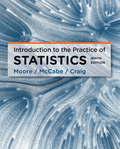
(a)
To test: Whether an 80% confidence interval would be wider or narrower than the 95% confidence interval obtained in Exercise 8.33.
(a)
Answer to Problem 34E
Solution: The 80% confidence interval would be narrower. An 80% confidence interval is obtained as
Explanation of Solution
Calculation: The 95% confidence interval is obtained as
The formula for 80% confidence interval for population proportion p is defined as:
Where,
The sample proportion is provided as:
Therefore, the sample proportion
The formula for margin of error m is defined as:
In the above formula,
The formula for standard error
The sample proportion
Therefore, the standard error is obtained as 0.0131. The value of
So, the margin of error is obtained as:
Therefore, the margin of error is obtained as 0.016768.
Substitute the obtained values of margin of error and sample proportion in the formula for confidence interval. Therefore, an 80% confidence interval is obtained as:
Therefore, an 80% confidence interval is obtained as
The width of the 80% confidence interval is obtained as:
The width of the 95% confidence interval is obtained as:
Conclusion: The obtained widths of the two confidence levels show that the 80% confidence interval is narrower than the 95% confidence interval.
(b)
To test: Whether a 98% confidence interval would be wider or narrower than the 95% confidence interval obtained in Exercise 8.33.
(b)
Answer to Problem 34E
Solution: A 98% confidence interval would be wider. A 98% confidence interval is obtained as
Explanation of Solution
Calculation: The 95% confidence interval is obtained as
The formula for 98% confidence interval for p is defined as:
The sample proportion is provided as:
Therefore, the sample proportion
The formula for margin of error m is defined as:
In the above formula,
The formula for standard error
The sample proportion
Therefore, the standard error is obtained as 0.0131. The value of
So, the margin of error is obtained as:
Therefore, the margin of error is obtained as 0.030523.
Substitute the obtained values of margin of error and sample proportion in the formula for confidence interval. Therefore, a 98% confidence interval is obtained as:
Therefore, a 98% confidence interval is obtained as
The width of the 98% confidence interval is obtained as:
The width of the 95% confidence interval is obtained as:
Conclusion: The obtained widths of the two confidence levels show that 98% confidence interval is wider than the 95% confidence interval.
Want to see more full solutions like this?
Chapter 8 Solutions
Introduction to the Practice of Statistics
- Business Discussarrow_forwardThe following data represent total ventilation measured in liters of air per minute per square meter of body area for two independent (and randomly chosen) samples. Analyze these data using the appropriate non-parametric hypothesis testarrow_forwardeach column represents before & after measurements on the same individual. Analyze with the appropriate non-parametric hypothesis test for a paired design.arrow_forward
- Should you be confident in applying your regression equation to estimate the heart rate of a python at 35°C? Why or why not?arrow_forwardGiven your fitted regression line, what would be the residual for snake #5 (10 C)?arrow_forwardCalculate the 95% confidence interval around your estimate of r using Fisher’s z-transformation. In your final answer, make sure to back-transform to the original units.arrow_forward
 MATLAB: An Introduction with ApplicationsStatisticsISBN:9781119256830Author:Amos GilatPublisher:John Wiley & Sons Inc
MATLAB: An Introduction with ApplicationsStatisticsISBN:9781119256830Author:Amos GilatPublisher:John Wiley & Sons Inc Probability and Statistics for Engineering and th...StatisticsISBN:9781305251809Author:Jay L. DevorePublisher:Cengage Learning
Probability and Statistics for Engineering and th...StatisticsISBN:9781305251809Author:Jay L. DevorePublisher:Cengage Learning Statistics for The Behavioral Sciences (MindTap C...StatisticsISBN:9781305504912Author:Frederick J Gravetter, Larry B. WallnauPublisher:Cengage Learning
Statistics for The Behavioral Sciences (MindTap C...StatisticsISBN:9781305504912Author:Frederick J Gravetter, Larry B. WallnauPublisher:Cengage Learning Elementary Statistics: Picturing the World (7th E...StatisticsISBN:9780134683416Author:Ron Larson, Betsy FarberPublisher:PEARSON
Elementary Statistics: Picturing the World (7th E...StatisticsISBN:9780134683416Author:Ron Larson, Betsy FarberPublisher:PEARSON The Basic Practice of StatisticsStatisticsISBN:9781319042578Author:David S. Moore, William I. Notz, Michael A. FlignerPublisher:W. H. Freeman
The Basic Practice of StatisticsStatisticsISBN:9781319042578Author:David S. Moore, William I. Notz, Michael A. FlignerPublisher:W. H. Freeman Introduction to the Practice of StatisticsStatisticsISBN:9781319013387Author:David S. Moore, George P. McCabe, Bruce A. CraigPublisher:W. H. Freeman
Introduction to the Practice of StatisticsStatisticsISBN:9781319013387Author:David S. Moore, George P. McCabe, Bruce A. CraigPublisher:W. H. Freeman





